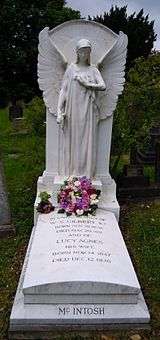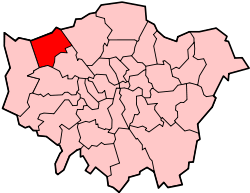Stanmore
Coordinates: 51°37′01″N 0°19′30″W / 51.6170°N 0.3250°W
Stanmore is a suburban residential district of northwest London in the London Borough of Harrow. It is centred 11 miles (18 km) northwest of Charing Cross. The area, based on the ancient parish of Great Stanmore includes southern slopes of the unnamed ridge of hills rising to Stanmore Hill, one of the highest points of London, 152 metres (499 ft) high. The population of the appropriate London Borough of Harrow Ward (Stanmore Park) was 11,229 at the 2011 Census.[1]
Toponymy
The area was recorded in the Domesday Book as Stanmere, the name deriving from the Old English stan, 'stony' and mere, 'a pool'. There are outcrops of gravel on the clay soil here and the mere may have been one of the ponds which still exist. By 1574 the area had become known as Great Stanmore to distinguish it from Little Stanmore.
History
Stanmore Village railway station was open for train services between 1890 and 1952. Stanmore tube station opened in 1932.
Stanmore had an outstation from the Bletchley Park codebreaking establishment, where some of the Bombes used to decode German Enigma messages in World War Two were housed.
Andrew Drummond, the founder of the Drummond bank in Charing Cross purchased the Stanmore estate in 1729 .[2]
Stanmore was also home to RAF Bentley Priory from where the Battle of Britain was controlled, also formerly to RAF Stanmore Park, HQ of Balloon Command. RAF Stanmore Park closed in 1997 and is now a housing estate and RAF Bentley Priory closed in 2009.
Parish Church
The first Parish Church was the 14th century St Mary's, built on the site of a wooden Saxon church which itself may have been built on the site of a Roman compitum shrine.[3][4] It has now completely disappeared; one tomb survives in a back garden.[3][5]
This building was replaced by a new one built in the current churchyard consecrated in 1632 and dedicated to St John the Evangelist.[3][4] Built of brick and consecrated by Archbishop Laud, it is one of the relatively small number of churches built in Britain between the medieval period and the eighteenth century.[3] By the nineteenth century, this church had become considered outdated and unsafe. After its replacement, its roof was pulled off and it became a ruin.
A new church was constructed in the Gothic Revival style from 1849-50. Queen Adelaide's last public appearance was to lay the foundation stone of the new church. She gave the font and when the church was completed after her death, the east window was dedicated to her memory.[6]
Modern Stanmore
The suburb is characterised by numerous small restaurants and cafés, several public houses, many unique shops like a natural health store and boutique-style clothing stores. The centre of Stanmore is dominated by the presence of a large Sainsbury's supermarket and also a large Lidl supermarket. There are also eateries such as Prezzo and Costa Coffee in the centre of the town. Stanmore's extensive residential areas are mainly leafy and predominantly affluent, with many residents commuting daily to jobs in central London including the City.
The public amenity of Stanmore Park is at the foot of Stanmore Hill and right next to the local library. This is just one of the two outdoor leisure fields, the other being Whitchurch Playing Fields adjacent to Whitchurch First and Middle School and opposite to Stanburn First and Middle School. The playing field hosts many Sunday league football matches on the individual football pitches with respective goal frames.
On the border with Bushey is Stanmore Cricket Club, one of the oldest in the Middlesex county championship league which celebrated 150 years in 2003 and is still successful at the present. The club has nurtured two famous cricketers who have played Tests for England in the last two decades; Angus Fraser and Mark Ramprakash.
Stanmore is home to Park High School, Stanmore College (a government further education establishment) and a local library run by the London Borough of Harrow. North London Collegiate School, one of the UK's top public schools for girls is in Stanmore. The suburb also hosts the Royal National Orthopaedic Hospital - known as RNOH - which is famed for its spinal unit.
Demography
Stanmore has Christian, Shia Muslim, Hindu, Jain, Jewish and Catholic communities, including its local Synagogue, Stanmore and Canons Park Synagogue on London Road (which has one of the largest memberships of any single synagogue in Europe and the second largest in the UK behind Borehamwood),[7] an Islamic Centre, KSIMC Of London (Hujjat)[8] and new Hindu Temple[9] on Wood Lane.
In the 2011 census in Stanmore Park ward, 56% of the population was white (47% British, 7% Other, 2% Irish) and 20% Indian. 31% was Christian, 22% Jewish, 15% Hindu and 11% Muslim.[10] Canons ward (covering eastern areas) was 52% white (40% British, 10% Other, 2% Irish) and 24% Indian. 26% was Christian, 25% Jewish, 18% Hindu and 11% Muslim.[11]
Notable natives and residents

- Queen Adelaide (1792–1849), queen consort of William IV, lived at Bentley Priory, Stanmore from 1848 until death
- George Hamilton-Gordon, 4th Earl of Aberdeen — Peelite Prime Minister (in office December 1852 – February 1855); was raised and is buried in Stanmore
- W.S. Gilbert — English dramatist, librettist and illustrator; lived at Grims Dyke, died in the lake there. Ashes buried in Stanmore.
- Robert and Ellen Hollond lived here. He was a balloonist and MP, she founded London's first créche.[12]
- Clement Attlee — Labour Prime Minister in the first post-war government; lived in a large villa "Heywood", later replaced by mid rise apartments
- Chaz Jankel, singer and multi-instrumentalist, was born in Stanmore
- Billy Idol, rock musician, was born in Stanmore
- Dave Bassett, football coach, was born in Stanmore
- Clive Anderson, radio and television presenter, was born in Stanmore
- Peter Van Hooke, drummer, was raised in Stanmore
- Linda Hayden, actress, was born in Stanmore
- Anthony Horowitz, screenwriter and author, was born in Stanmore
- Cyril Shaps, actor, lived in Stanmore
- Roger Moore, actor, famous for his role as James Bond and in The Saint, lived in Stanmore.
- Patricia Medina, second wife of Joseph Cotten, actor, lived in Stanmore.[13]
- Theo Walcott, footballer, Arsenal FC and England, was born in Stanmore.[14]
- Keith Vaz, MP, (Lab) lives in Stanmore
- Olly Mann, co-host of cult podcast, Answer Me This!.[15]
- James Bord, professional poker player
- Bacary Sagna a professional footballer lived in Stanmore until 2014 while at Arsenal FC
- Jay Foreman, musical comedian, was raised in Stanmore
- Beardyman (Darren Foreman), performer and musician, was raised in Stanmore
- Matt Lucas, Performer and comedian, was born in Stanmore.
- Alexis Sanchez a professional footballer playing for Arsenal FC currently lives in Stanmore
Transport
Nearby places
Tube/Trains
- Stanmore tube station is the northern terminus of the Jubilee line.
Main bus routes
| Route | Start | End | Operator |
| 142 | Brent Cross | Watford Junction | Arriva Shires & Essex |
| 324 | Stanmore | Brent Cross | London Sovereign |
| 340 | Edgware | Harrow | Arriva Shires & Essex |
| H12 | Stanmore | South Harrow | Metroline |
| N98 | Stanmore | Holborn | Metroline |
| 615 not a London bus route |
Hatfield | Stanmore | Uno |
External links
References
- ↑ "Harrow Ward population 2011". Neighbourhood Statistics. Office for National Statistics. Retrieved 24 October 2016.
- ↑ H Bolitho and D Peel, The Drummonds of Charing Cross (London: George, Allen & Unwin, 1967)
- 1 2 3 4 Ellis, Mike (1996-12-26). "Notes about the Churches of Great Stanmore". Short History of Stanmore. Mike Ellis. Retrieved 15 January 2010.
- 1 2 Archived 9 February 2012 at the Wayback Machine.
- ↑ "Great Stanmore: Church". British History Online. Victoria County History. Retrieved 20 September 2016.
- ↑ T F T Baker, R B Pugh (Editors), A P Baggs, Diane K Bolton, Eileen P Scarff, G C Tyack (1976). "Great Stanmore: Church". A History of the County of Middlesex: Volume 5: Hendon, Kingsbury, Great Stanmore, Little Stanmore, Edmonton Enfield, Monken Hadley, South Mimms, Tottenham. Institute of Historical Research. Retrieved 3 April 2013.
- ↑ "Stanmore Synagogue Home Page". Sacps.org.uk. 1999-01-12. Retrieved 2014-05-19.
- ↑ "Hujjat.org". Hujjat.org. Retrieved 2014-05-19.
- ↑ "Portal of Swaminarayan". Swaminarayan Satsang. 2013-01-19. Retrieved 2014-05-19.
- ↑ http://www.ukcensusdata.com/stanmore-park-e05000303
- ↑ http://www.ukcensusdata.com/canons-e05000286
- ↑ Great Stanmore: Introduction', A History of the County of Middlesex: Volume 5: Hendon, Kingsbury, Great Stanmore, Little Stanmore, Edmonton Enfield, Monken Hadley, South Mimms, Tottenham (1976), pp. 88-96. URL: Date accessed: 12 May 2009.
- ↑ Medina Cotten, Patricia (1998). Laid back in Hollywood: Remembering. Los Angeles: Belle Publishing. pp. 1–2. ISBN 0-9649635-2-3.
- ↑ "Theo Walcott". TheFA.com. Retrieved 2014-05-19.
- ↑ "Olly Mann is a presenter, columnist and technology commentator.". ollymann.co.uk. Retrieved 30 November 2016.

